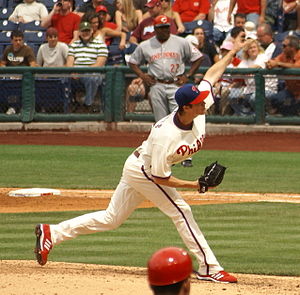Another slightly off topic discussion today, because it’s getting near the baseball playoffs. My team is in them- for the fourth year in a row. It’s also been a year when pitchers have really been in the news- and the number of pitcher injuries has been accelerating over the years. The Phillies (Lets Go Phils) have lost for most of this season the talents of baseball’s oldest pitcher- Jamie Moyer, and many of its players were out for weeks on end (but returned in time to prove that September is our favorite month). (Our other three aces- Roy Halliday, Roy Oswalt, and Cole Hamels have been healthy and in great shape.) The league bottom-dweller lost its hope when Steve Stasberg blew his arm. And, therein lies the problem.
There are all kinds of theories as to what’s the best pitching technique and style. But, we really don’t know. What we do know is that pitching injuries are cumulative from microtrauma to soft tissues over the course of time. Theories about the overuse have ranged from pitch counts, types, mechanics, as well as physical conditioning and nutrition, among others. We need to understand the biomechanics of pitching to minimize injury, preclude overuse syndrome, and evaluate the rehabilitation.
Enter Drs. Berkson and Gill (Massachusetts General Hospital) and Paradiso (MIT). They have developed a compact, wireless, wearable system that can monitor pitching and batting (among other physical activities that require bursts of action). This IMU (Inertial Measurement Unit) system is capable of employing six degree-of-freedom, battery-powered nodes that are worn on various places of the athlete’s body, coupled with sensors for both slow and fast motion. The data are acquired wirelessly and analyzed off-line. Previous to this development, pitching (as the example here) was analyzed in a controlled laboratory setting with various high-speed cameras tracking the action. Acceleration and velocity were derived from positional data.
In this case, the motions are picked up with an array of cameras and sensors, creating a series of dots that are then analyzed by computer. A biomechanical avatar of the individual is then produced that provides for 3-D imaging, demonstrating stresses and velocities (wrists, shoulders, arms, as well as other parts of the body). Now, we can monitor pitchers when they are healthy- and stressed- comparing the results. The athlete can compare the sequences in precise detail, determining what rehabilitation or re-learning steps are needed. Also, by know what puts too much stress on an elbow or a wrist, one can correct actions and preclude injuries. (You can see one short analysis of an ODU college pitcher here.)
All this while, we rabid Phanatics can enjoy our baseball. Let’s go enjoy the playoffs and the World Series.







